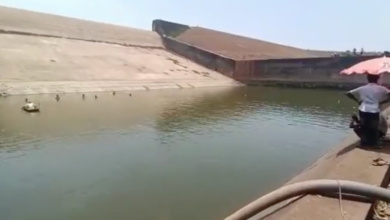Worst-ever contamination of Ireland’s largest lake: What’s to blame?

An algal bloom resurgence at Lough Neagh, the biggest freshwater body in the United Kingdom and Ireland, has renewed public debate about its ownership and management.
For months, extensive blue-green algal (cyanobacteria) growths have led to animal deaths, human sickness, temporary beach closures, and the permanent closure of businesses along the lake and connecting waterways. Regional agencies say the summer’s bloom reached “levels not seen since the 1970s”, while lough residents say they were the “worst” they have ever seen.
The contamination has prompted fears about the safety of drinking water in the region and the future survival of key industries at the lough.
Several grassroots initiatives have sprung up in response to the lough’s devastated condition.
There have also been attempts to recall Northern Ireland’s assembly – part of the region’s collapsed power-sharing arrangements, also known as Stormont – to address the ongoing “crisis” at one of Europe’s most important freshwater bodies.
What is Lough Neagh?
Lough Neagh is the largest freshwater body by surface area in the UK and Ireland, covering nearly 400 square km (154 square miles), an area greater than the size of Malta. It supplies more than 40 percent of Northern Ireland’s drinking water and more than half of its capital city, Belfast.
About 91 percent of the 4,550-sq km (1,756 sq miles) catchment area lies in Northern Ireland, says John Spence, a retired researcher specialising in aquatic systems management.
“Altogether, 43 percent of the land area of Northern Ireland drains into the lough, from which the waters flow out northwards to the Atlantic Ocean via the lower River Bann.”
The lough is a rich source of Irish mythology, having inspired many writers and artists. Its landscapes have been immortalised in verse by Nobel Laureate Seamus Heaney, who grew up by the northwest tip of Lough Neagh and the neighbouring Lough Beg.
Also, evidence of Ireland’s earliest settlements has been found along its adjoining rivers.
Why is it turning green?
So what’s causing the extensive growths – referred to as “blue-green algae” thanks to its green and brilliant-blue appearance, which are a kind of photosynthesising bacteria – that have swept the lough this summer? The primary source is exceedingly high levels of phosphates and nitrates, along with other contaminants.
The key culprits: two-thirds of the phosphate that ends up in the lough originates from slurry and other run-off from surrounding farmland, while 24 percent comes from human sewage discharged into the lough’s catchment area. Other factors, including industrial sand extraction, may also be accelerating the eutrophication (nutrient-loading) process that has allowed the algae to flourish.
One study suggested that climate change may, additionally, be a contributing factor.
The wettest July on record in Northern Ireland, followed by prolonged spells of warm weather in August and early September, have served as more immediate triggers for the surge in algal growths.
Les Gornall, an expert who has worked on the environmental impacts of slurry for decades, explains that the lake’s “hypereutrophic” classification made the algal blooms nearly inevitable. Hypereutrophication results when increasing concentrations of plant nutrients in water bodies lead to increased biological productivity.
“This change resulted from the lake’s response to an influx of nutrients, particularly soluble reactive phosphorus (SRP) and nitrogen,” Gornall said.
According to Gornall, only a “tiny amount of SRP” – phosphorous quantities similar in size to a couple of AAA batteries – is needed to trigger an algal bloom.
“In pollution-free lakes, one would find a concentration of only one or two of these [battery-sized] ‘SRP units’ in the pristine water. In 2023, SRP levels in the [Lough] surged to seven-either units.
“This pollution level elevates the likelihood of a toxic blue-green algal bloom to over 80 percent. Without controls on phosphorus input, this level of SRP will increase and the lough may become unrecoverable.”










